JNDI in Wildfly: Part 2 - The remote naming service
JNDI in Wildfly: Part 2 - The remote naming service
In this article, let’s check the Wildfly Remote Naming Service.
In the previous article, we have checked NamingStore and NamingsService. We understand that the purpose of the NamingService is to enable NamingStore during Wildfly startup process. In addition to this process, Wildfly also need to enable remote naming service, so the users can access the service from other machines via network.
Here is the relative configuration in standalone.xml:
$ grep -C 2 'remote-naming' standalone.xml
</subsystem>
<subsystem xmlns="urn:jboss:domain:naming:2.0">
<remote-naming/>
</subsystem>
<subsystem xmlns="urn:jboss:domain:pojo:1.0"/>
From the above configuration, we can see in basic standalone mode, the Wildfly naming subsystem will enable the ‘RemoteNamingServerService will enable the remote naming service. Here is the class diagram of the RemoteNamingServerService:
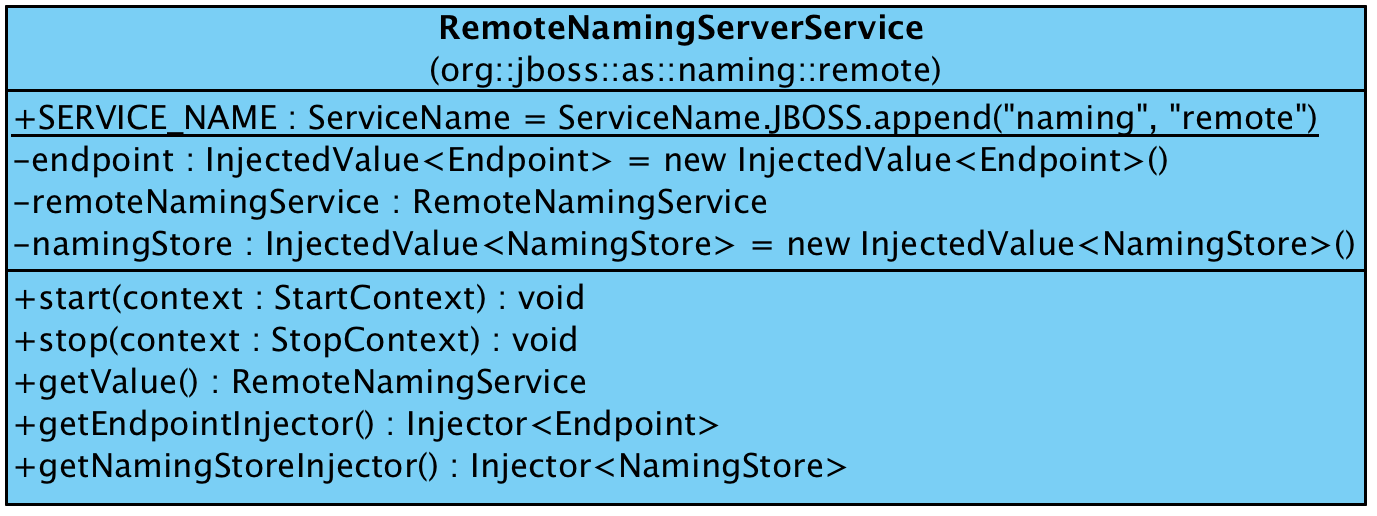
From the above diagram, we can see the the RemoteNamingServerService contains the remoteNamingService and namingStore. We have learned the namingStore is the backend repository of the registered naming resources. On the other hand, the remoteNamingService is the class that provides naming service remote access ability.
In addition, RemoteNamingServerService will inject NamingStore into RemoteNamingService. Here is the relative code in
theRemoteNamingServerService class:
public synchronized void start(StartContext context) throws StartException {
try {
final Context namingContext = new NamingContext(namingStore.getValue(), new Hashtable<String, Object>());
remoteNamingService = new RemoteNamingService(namingContext, executorService.getValue(), RemoteNamingLogger.INSTANCE);
remoteNamingService.start(endpoint.getValue());
} catch (Exception e) {
throw new StartException("Failed to start remote naming service", e);
}
}
The above code shows the logic of the start(...) method: It will create a namingContext with namingStore included, and then register the namingContentxt into remoteNamingServer. Finally it starts the remoteNamingService by calling its start(...) method.
So we should focus on checking the RemoteNamingService class provided by the jboss-remote-naming project to see how it’s implemented. Before that, we need to fetch the source code of the jboss-remote-naming project. You can find the source code of this project on Github. Here is the URL of the project:
https://github.com/jbossas/jboss-remote-naming
You need to clone the above repository to your local machine to check the source code. Here is the screenshot of the project in my IDE:
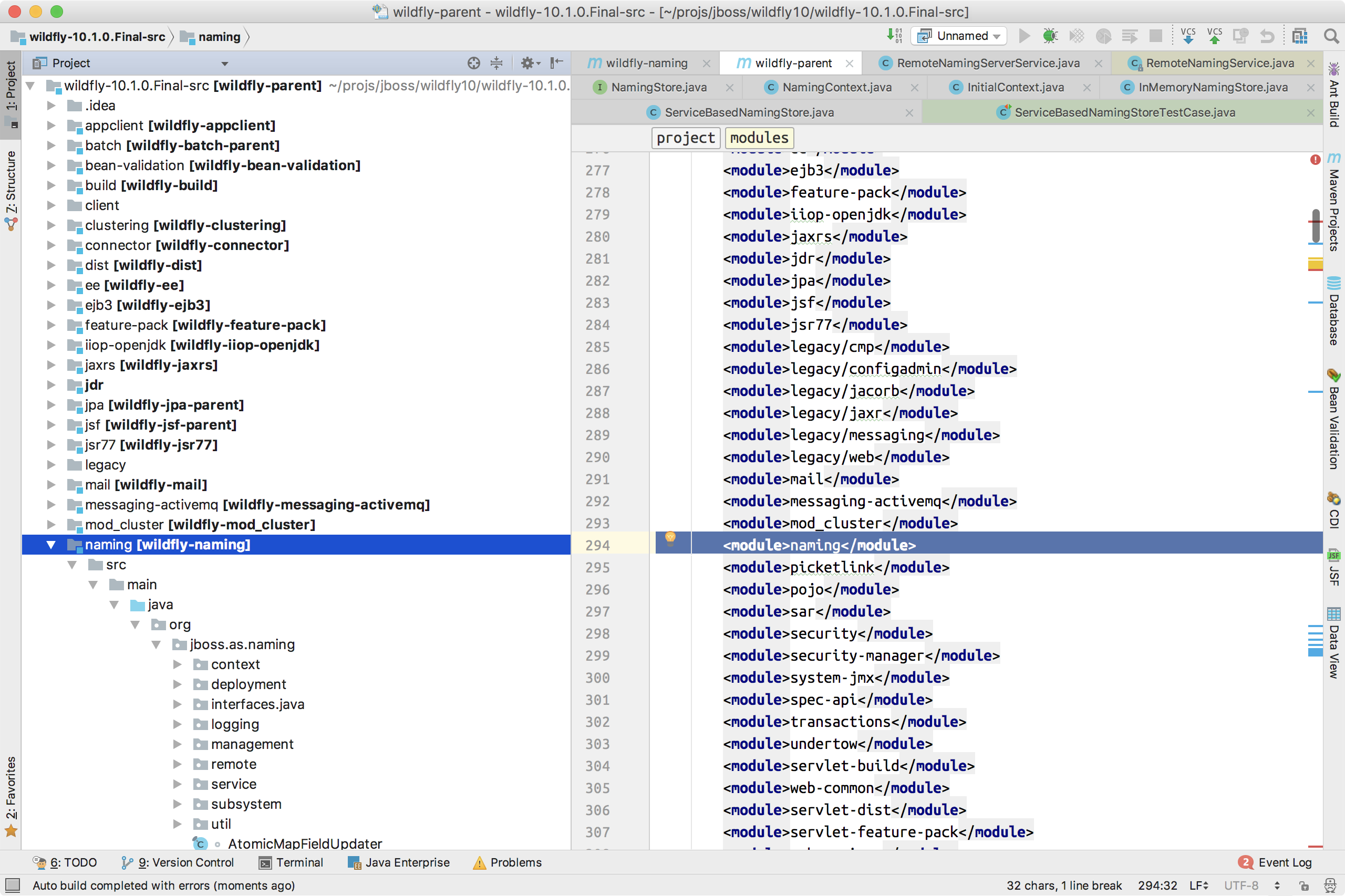
From the above screenshot, you can see the project structure of the jboss-remote-naming project.
Now let’s see the class diagram of the RemoteNamingService class:
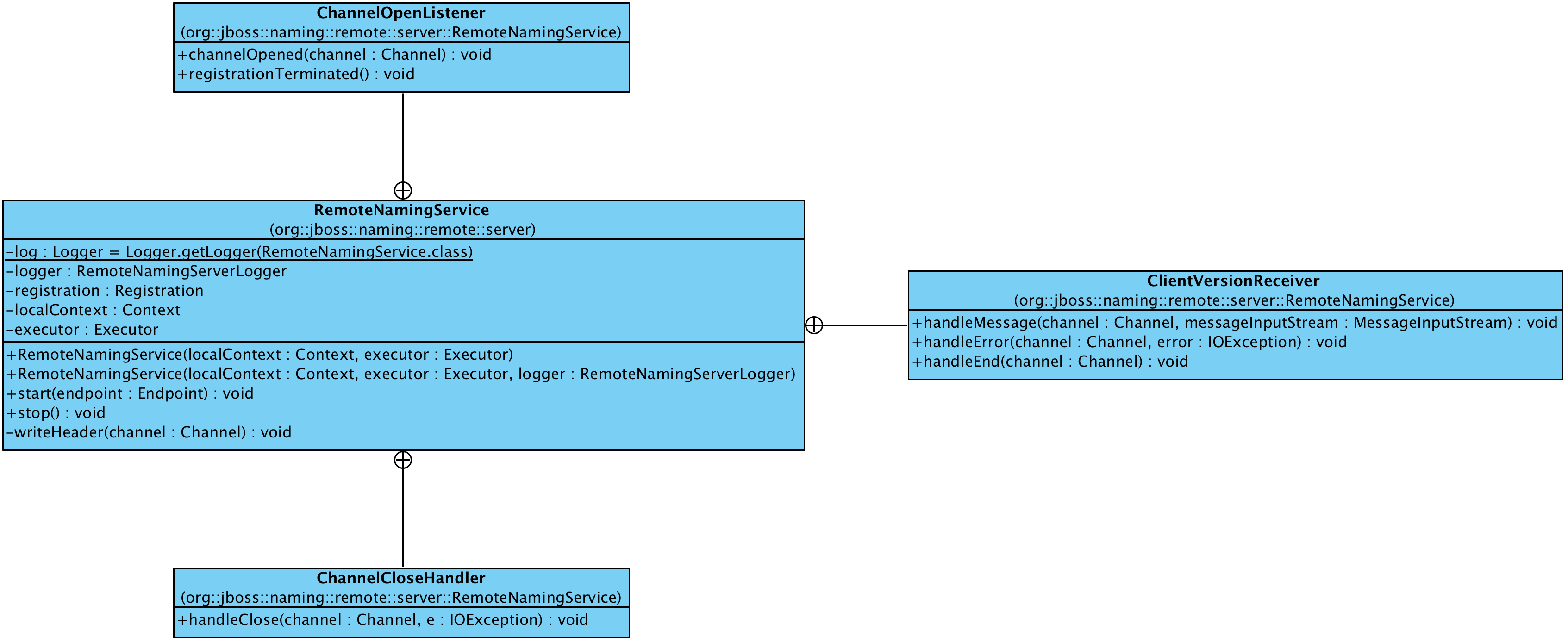
From the above diagram, we can see the RemoteNamingService and its inner classes. We know the service loading process in Wildfly is asynchronous, so from above diagram, we can see RemoteNamingService will use ChannelOpenListener and ChannelCloseHandler to manage the service lifecycle. There is an additional ClientVersionReceiver inner class in the diagram, and we will check its usage later.
The next step we can check the start(...) method of the RemoteNamingService. Here is the sequence diagram of the method:
.png)
From the above sequence diagram, we can see the start(...) method of RemoteNamingService is just to register the ChannelOpenListener. Now let’s see the code of ChannelOpenListener:
private class ChannelOpenListener implements OpenListener {
public void channelOpened(Channel channel) {
log.debugf("Channel Opened - %s", channel);
channel.addCloseHandler(new ChannelCloseHandler());
try {
writeHeader(channel);
channel.receiveMessage(new ClientVersionReceiver());
} catch (IOException e) {
logger.failedToSendHeader(e);
IoUtils.safeClose(channel);
}
}
public void registrationTerminated() {
}
}
From the above code, we can see the ChannelOpenListener uses ClientVersionReceiver to handle the received message. From the above diagram, we can see the ClientVersionReceiver has a handleMessage(...) method. This method is used to handle the received message. Let’s see the code of handleMessage(...) message:
public void handleMessage(Channel channel, MessageInputStream messageInputStream) {
DataInputStream dis = new DataInputStream(messageInputStream);
try {
byte[] namingHeader = new byte[6];
dis.read(namingHeader);
if (!Arrays.equals(namingHeader, NAMING)) {
throw new IOException("Invalid leading bytes in header.");
}
byte version = dis.readByte();
log.debugf("Chosen version 0x0%d", version);
Versions.getRemoteNamingServer(version, channel, RemoteNamingService.this);
} catch (IOException e) {
logger.failedToDetermineClientVersion(e);
} finally {
IoUtils.safeClose(dis);
}
}
The above code shows that it will read the namingHeader from the received message via network, and determines the correct RemoteNamingServer to use. Actually there is only one version of RemoteNamingServer currently, and it’s named RemoteNamingServerV1. Here is the class diagram of the RemoteNamingServer and its implementation:
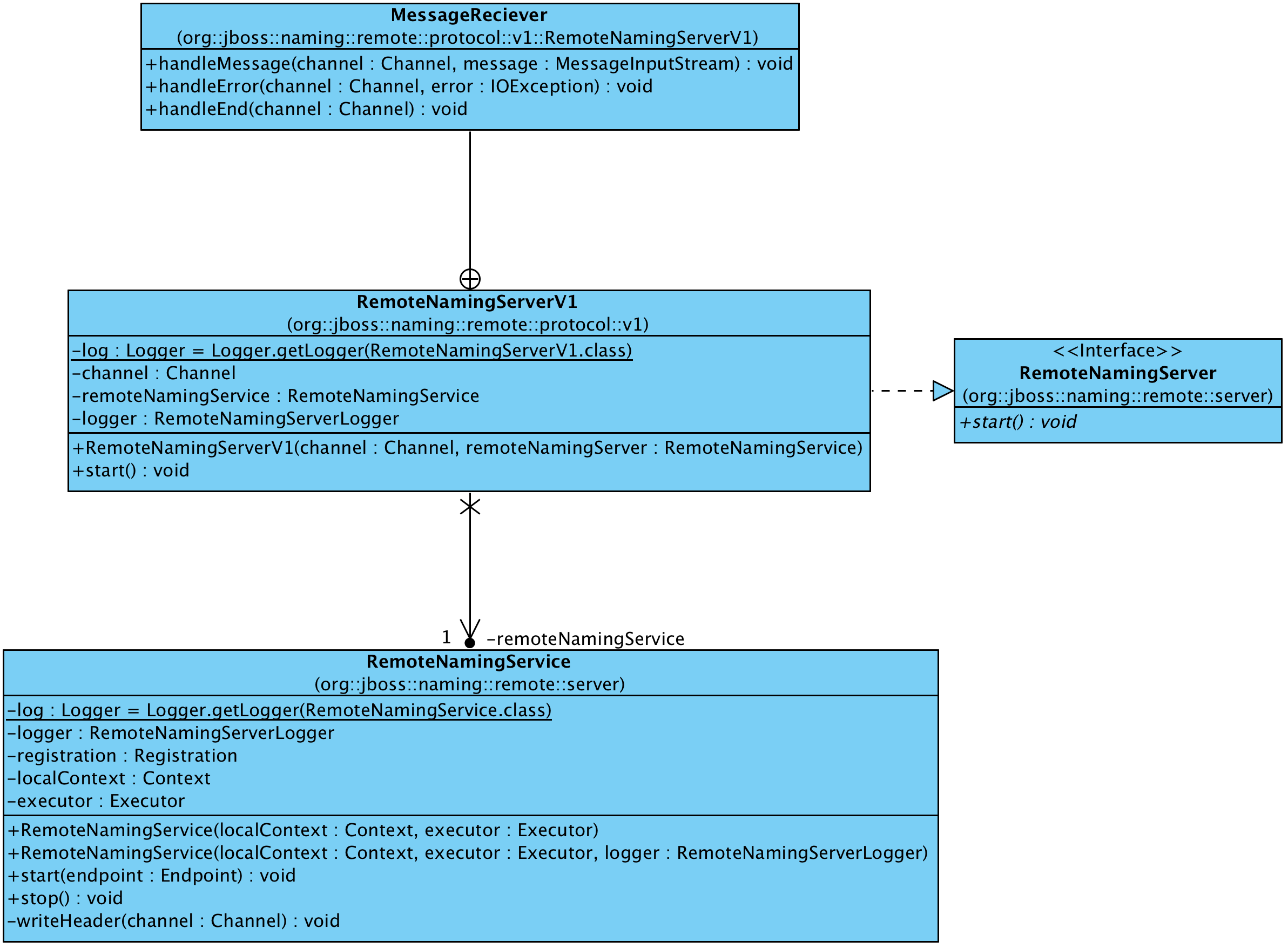
From the above diagram, we can see RemoteNamingServer currently has one version of implementation, which is RemoteNamingServerV1. In addition, we can see the RemoteNamingServerV1 contains MessageReceiver to deal with the incoming request.
We can see the full package name of RemoteNamingServerV1 is org.jboss.naming.remote.protocol.v1. In this package, it contains the current implementation of the remote naming server. In the package, it contains a Protocol class that implements the relative JNDI operations. Here is the screenshot of the class:
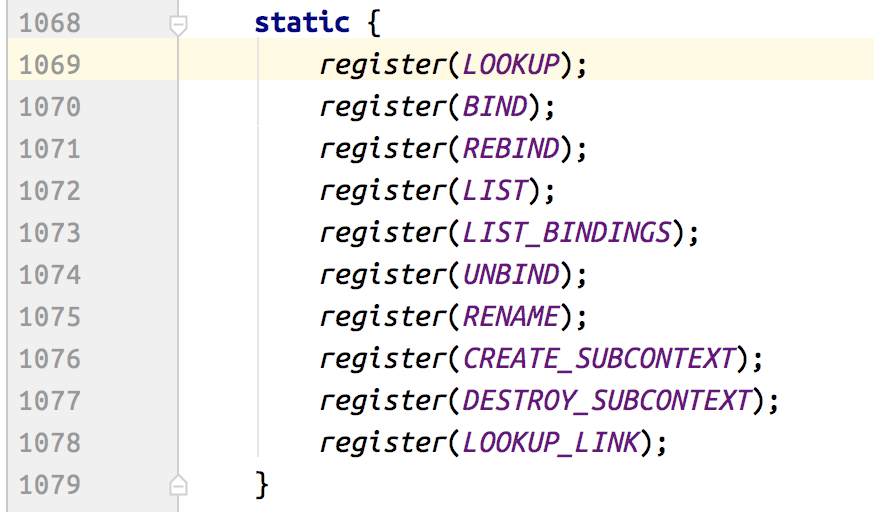
From the above screenshot, we can see the operations implemented by the class. Because the Protocol class is very big and it contains a thousand lines of code, so I won’t explain its detail implementation here.
Now let’s check the RemoteNamingStore interface and its implementation RemoteNamingStoreV1. Here is the class diagram of them:
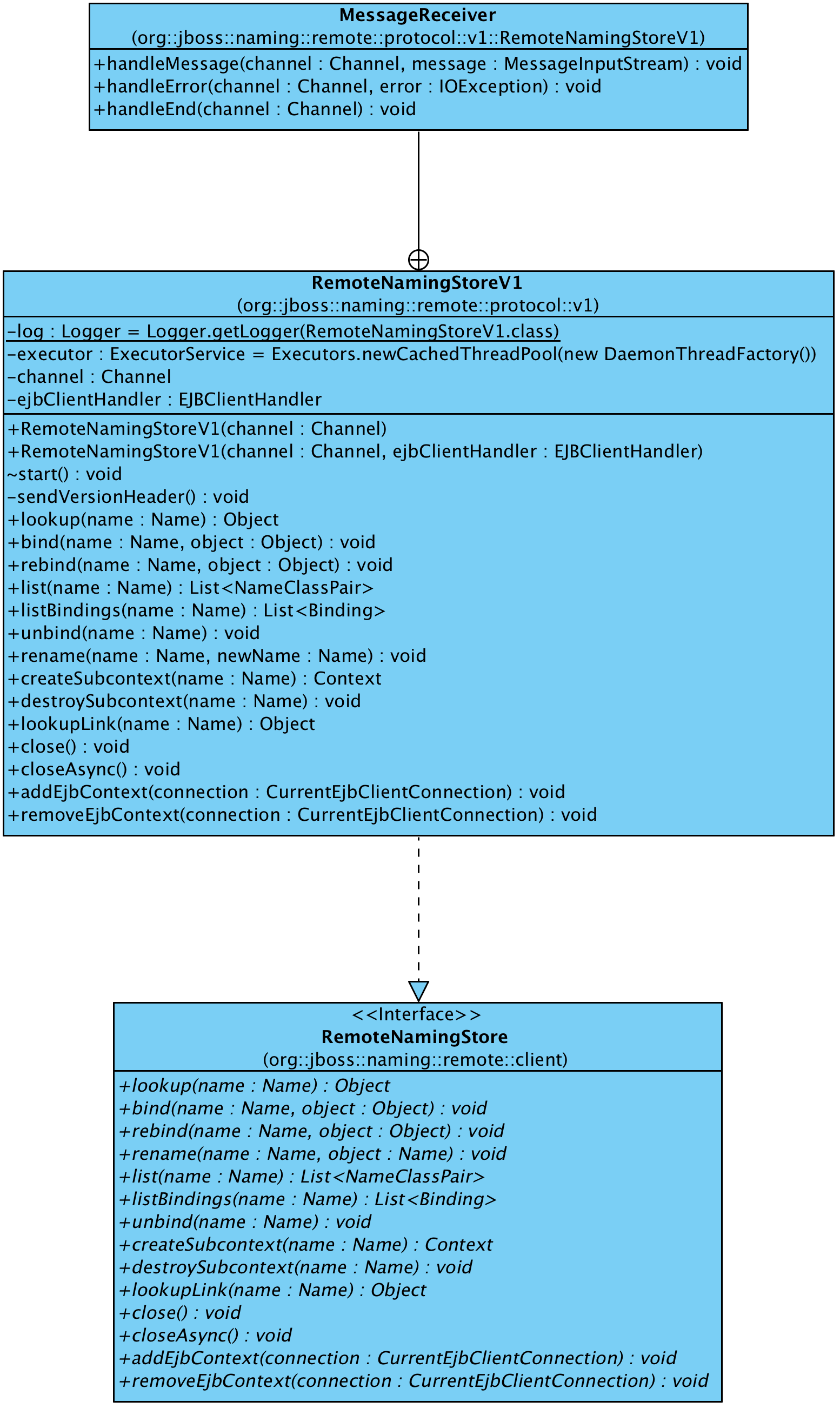
From the above diagram, we can see the RemoteNamingStore is used to store the naming resources provide the resources via JNDI operations.
What’s the relationship of the RemoteNamingStore interface and the RemoteNamingServer interface? To answer this question, we can check the ProtocolCommand interface. Here is the class diagram of the interface:

From the above diagram, we can see the ProtocolCommand defines two methods: one is handleServerMessage(...) and the other is handleClientMessage(...).
In handleServerMessage(...) method, it uses the remoteNamingService (There is currently a typo in the class, and I have submitted the PR to fix it. See: fix a minor typo in ProtocolCommand #32) to interact with the naming service provider(The Wildfly server in our case).
In handleClientMessage(...) method, it uses the namingStore to deal with the user requests. This is very similar to the situation we have see in the previous article, which Wildfly uses the local NamingStore to deal with the local JNDI requests.
The ProcotolCommand interface is implemented in each JNDI operation defined in the Protocol class. For example, here is the code in Protocol class that implements the JNDI LOOKUP operation:
class Protocol {
static ProtocolCommand<Object> LOOKUP = new BaseProtocolCommand<Object, ClassLoadingNamedIoFuture<Object>>((byte) 0x01) {
public void handleServerMessage(Channel channel, final DataInput input, final int correlationId, final RemoteNamingService remoteNamingService) throws IOException {
final Unmarshaller unmarshaller = prepareForUnMarshalling(input, this.getClass().getClassLoader());
Name name;
try {
byte paramType = unmarshaller.readByte();
if (paramType != NAME) {
remoteNamingService.getLogger().unexpectedParameterType(NAME, paramType);
}
name = unmarshaller.readObject(Name.class);
} catch (ClassNotFoundException cnfe) {
throw new IOException(cnfe);
} finally {
unmarshaller.close();
}
try {
final Object result = remoteNamingService.getLocalContext().lookup(name);
write(channel, new WriteUtil.Writer() {
public void write(DataOutput output) throws IOException {
output.writeByte(getCommandId());
output.writeInt(correlationId);
output.writeByte(SUCCESS);
if (result instanceof Context) {
output.writeByte(CONTEXT);
} else {
output.writeByte(OBJECT);
final Marshaller marshaller = prepareForMarshalling(output);
marshaller.writeObject(result);
marshaller.finish();
}
}
});
} catch (NamingException e) {
writeExceptionResponse(channel, e, getCommandId(), correlationId);
}
}
public void handleClientMessage(final DataInput input, final int correlationId, final RemoteNamingStore namingStore) throws IOException {
readResult(correlationId, input, new ValueReader<ClassLoadingNamedIoFuture<Object>>() {
public void read(final DataInput input, ClassLoadingNamedIoFuture<Object> future) throws IOException {
byte parameterType = input.readByte();
switch (parameterType) {
case OBJECT: {
try {
final Unmarshaller unmarshaller = prepareForUnMarshalling(input, future.getClassLoader());
future.setResult(unmarshaller.readObject());
unmarshaller.finish();
} catch (ClassNotFoundException e) {
throw new IOException(e);
} catch (ClassCastException e) {
throw new IOException(e);
}
break;
}
case CONTEXT: {
future.setResult(new RemoteContext(NamedIoFuture.class.cast(future).name, namingStore, new Hashtable<String, Object>()));
break;
}
default: {
throw new IOException("Unexpected response parameter received.");
}
}
}
});
}
};
}
I have removed unrelated code and in above you can see how does the LOOKUP operation implements the ProtocolCommand interface, and how the namingStore and namingService are used in the methods. We can see the Protocol class uses the ProtocolCommand to provide services to both server side (Wildfly) and user side. Compared with the local naming service in Wildfly source base as we see in last article, the remote design is more complex.
Above are all the topics I want to say in this article. In the next article, let’s see the network communication layer of the jboss-remote-naming project.